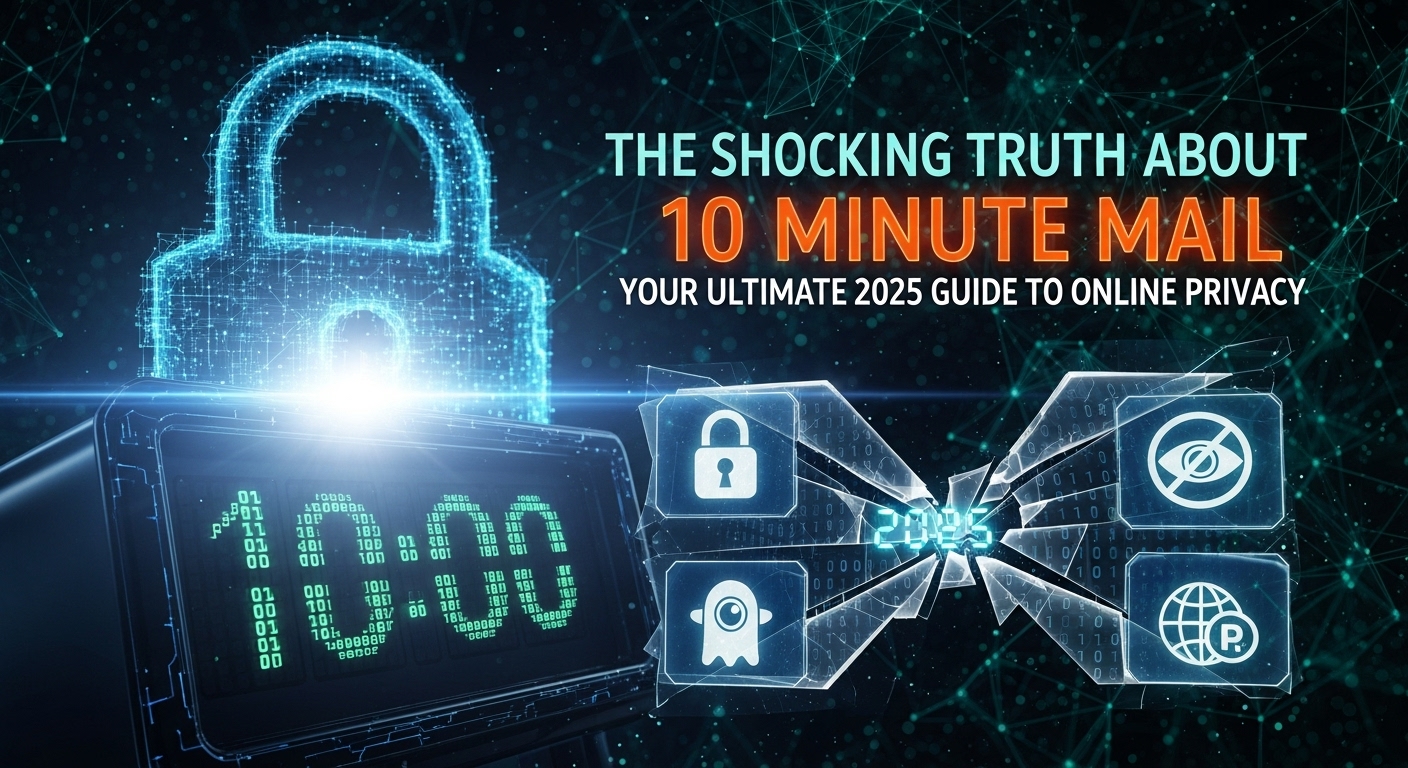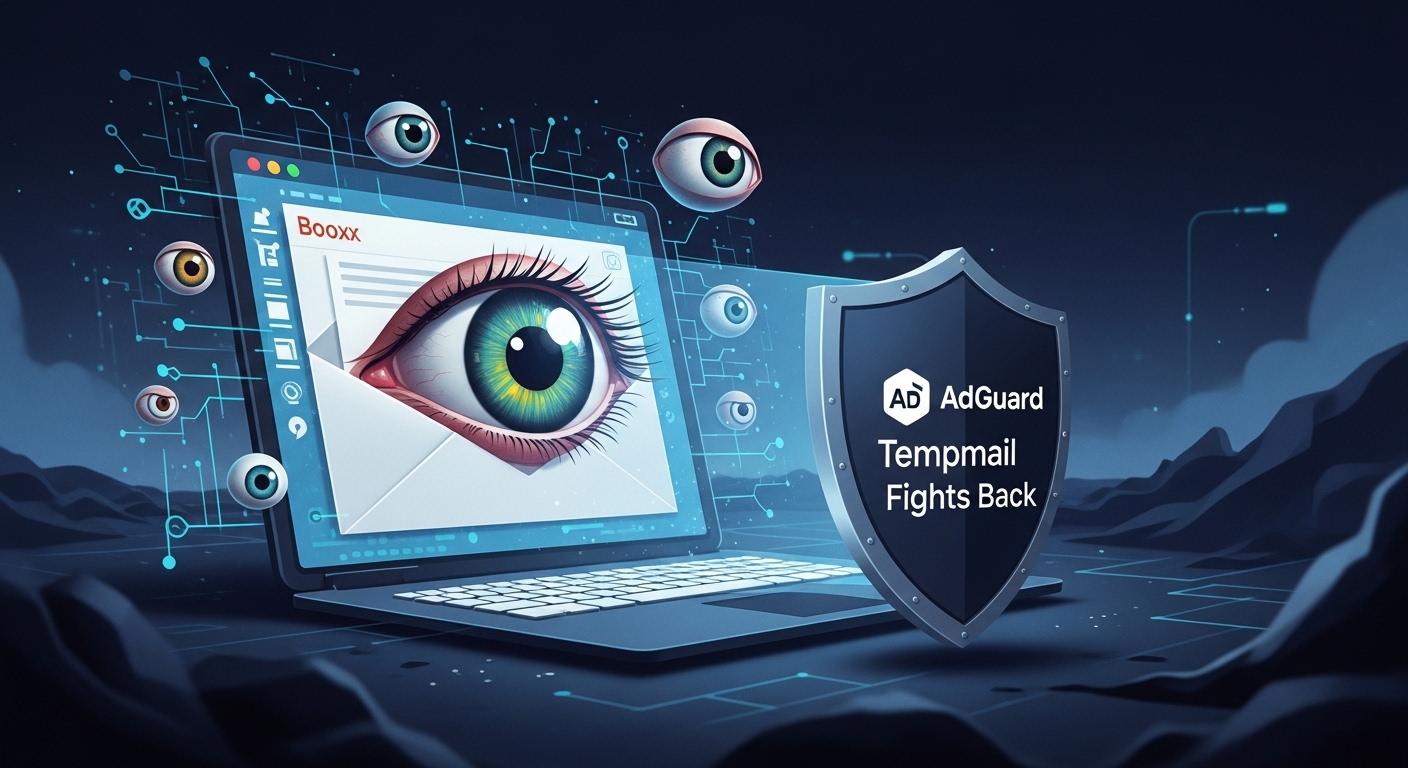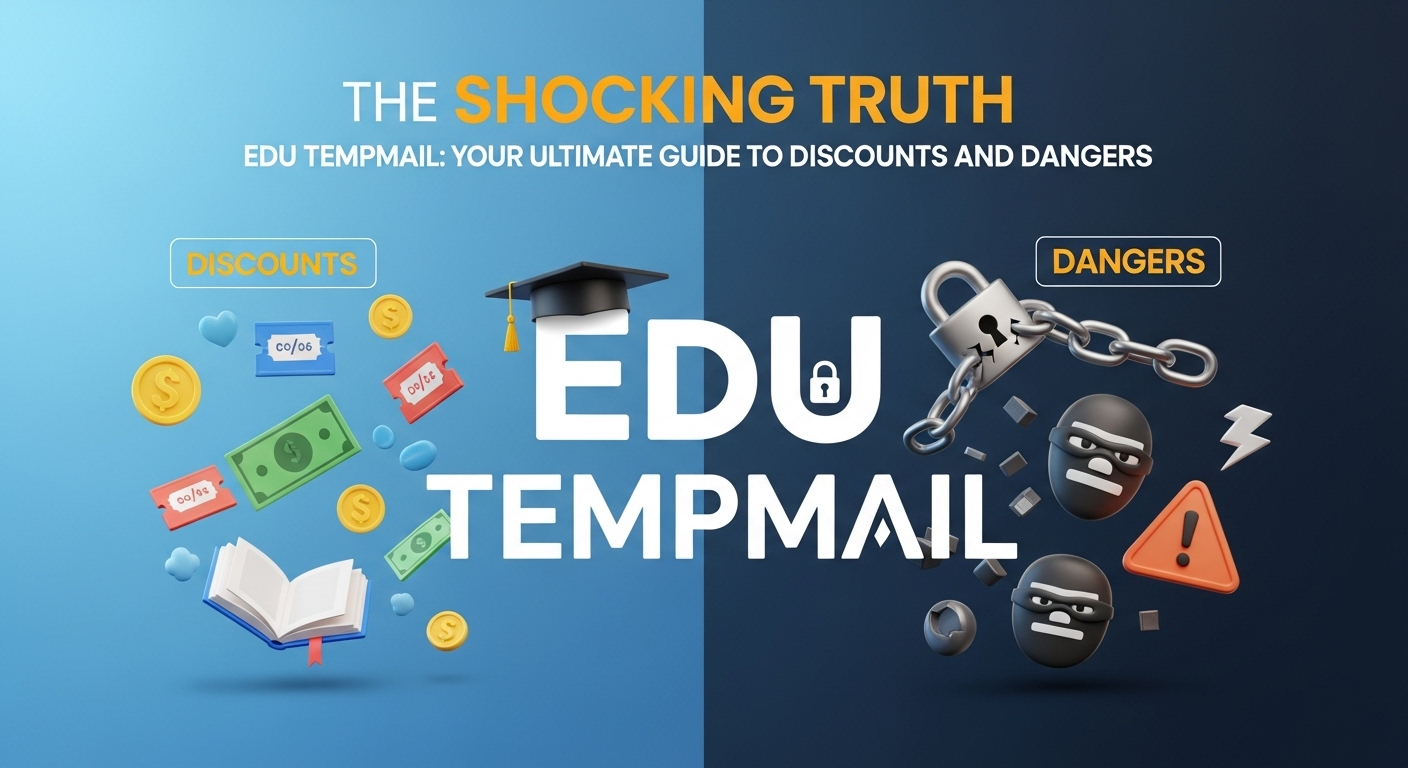The Shocking Truth About 10 Minute Mail: Your Ultimate 2025 Guide to Online Privacy

Ever found yourself on a website, ready to download a free e-book or grab a 15% discount code, only to be stopped by a single, mandatory field: "Enter your email address"? You hesitate for a moment. You know what comes next—the endless stream of promotional newsletters, the "special offers" you never asked for, and the constant worry about where your data might end up. In the digital world, "free" often comes at a hidden price: your privacy.
This isn't just a feeling; it's a statistical reality. An estimated 3.4 billion phishing emails are sent every single day. By 2025, the total number of emails sent and received daily is projected to hit a staggering 376.4 billion, making your inbox a prime target for spammers and scammers. Every time you hand over your email address, you're not just signing up for a newsletter; you're rolling the dice with your personal data.
Why You Need a Temporary Email:
The benefits of a disposable email address become crystal clear when you see it in action. It’s not just for the ultra-paranoid; it’s a practical tool for everyday online life. Here are seven situations where a 10 minute mail can be a game-changer.
- Accessing Gated Content Without the Spam
- The Scenario: You find the perfect guide, "The Ultimate Guide to Container Gardening," but it's locked behind a download form. You want the guide, but you don't want a lifetime subscription to "Brenda's Blog on Begonias."
- The Solution: Use a 10 minute mail address. You get the download link in your temporary inbox, grab the PDF, and abandon the address forever. No follow-up emails, no spam, just pure, unadulterated knowledge.
- Safely Testing New Apps and Websites
- The Scenario: You're a small business owner curious about a new project management tool. You want to try the free trial, but you're hesitant to give your professional email, fearing a flood of sales calls and marketing emails.
- The Solution: Sign up with a temporary email. You can explore every feature of the app without commitment. If you don't like it, you simply walk away. No digital trace, no need to unsubscribe, and no awkward "just checking in" emails from their sales team.
- Grabbing One-Time Discounts and Coupons
- The Scenario: An online store offers you a 15% discount on your first purchase if you sign up for their newsletter. You want the discount, but your primary inbox is already a warzone of retail promotions.
- The Solution: A burner email gets you the coupon code instantly. You apply it at checkout, save money, and never hear from that store again. It’s the ultimate way to be a savvy shopper without the long-term inbox clutter.
- Protecting Your Privacy on Public Wi-Fi
- The Scenario: You're at a coffee shop or airport, and the free Wi-Fi requires an email address to log in. Public networks are notoriously insecure, making it a risky place to share your real credentials.
- The Solution: A 10 minute mail address lets you connect without exposing your primary email to potential snoops or the Wi-Fi provider's marketing list. You get online safely and anonymously.
- Entering Contests and Giveaways with Confidence
- The Scenario: You see a chance to win a new gadget, but the entry form feels like a direct pipeline to every marketing database on the planet.
- The Solution: Use a temporary address to enter. If you win, you'll see the notification in your temporary inbox. If you don't, you've lost nothing and successfully avoided being added to countless spam lists.
- Posting Anonymously on Forums and Blogs
- The Scenario: You want to join a discussion about a sensitive topic or ask a question on a public forum without it being tied to your real-world identity.
- The Solution: Register for the forum with a 10 minute mail address. It allows you to participate in the conversation while keeping your personal and professional lives completely separate.
- Shielding Yourself from Data Breaches
- The Scenario: You sign up for a small, niche website that seems interesting. Six months later, that site gets hacked, and its user database is leaked online.
- The Solution: If you used a temporary email, your real address is safe. The leaked address is a dead end, protecting your primary account from being targeted by hackers who exploit breach data.
How to Use a 10 Minute Mail in Under 60 Seconds (A Video Guide)
Using a 10 minute mail service is incredibly fast and intuitive. There are no complicated sign-ups or confusing interfaces. Here’s a simple, four-step process to get you started.
- Visit a Provider: Open your web browser and navigate to a temporary email service. Classic options like 10MinuteMail.com work well, but for a modern and reliable experience, you can try a service like (https://temptomail.org).
- Copy the Generated Address: The moment the page loads, you'll see a freshly generated temporary email address. Simply click the "Copy" button next to it.
- Paste and Sign Up: Go to the website or app that's asking for your email and paste the address into the sign-up form. Complete their registration process as you normally would.
- Check Your Temporary Inbox: Switch back to the 10 minute mail tab. The confirmation email should appear in the inbox on that page within seconds. Click the verification link, and you're done!
If an email takes a little longer to arrive, don't worry. Most services offer a button to extend your session, typically adding another 10 minutes to the clock.
To see just how easy it is, watch this quick video tutorial:
The Good vs. The Bad: A Clear-Cut Look at 10 Minute Mail
Every tool has its strengths and weaknesses, and 10 minute mail is no exception. Understanding its trade-offs is key to using it smartly. Here’s a straightforward comparison to help you decide when it’s the right choice.
| Pros (The Upside) | Cons (The Downside) |
| Ultimate Privacy | No Account Recovery |
| Keeps you anonymous by not requiring any personal information for sign-up. | If you forget a password for a service you signed up for, you're permanently locked out. |
| Zero Spam | Major Security Risks |
| Protects your main inbox from being flooded with junk mail and marketing lists. | Inboxes are often public and unencrypted, meaning anyone with the address might see your emails. |
| Instant Access | Frequently Blocked |
| Get a working email in seconds with no registration or password needed. | Many popular websites and services actively block domains from known temporary email providers. |
| No Commitment | Not for Important Services |
| The address self-destructs, leaving no digital trail or need to unsubscribe. | Never use it for banking, social media, or anything you need long-term, secure access to. |
The Best 10 Minute Mail Providers of 2025
While dozens of temporary email providers exist, they are not all created equal. Some prioritize speed, while others offer more features. Here is a comparison of the top players to help you choose the best one for your needs.
| Provider | Key Feature | Lifespan | Best For | Outbound Link |
| 10MinuteMail | Extreme simplicity, strict 10-minute timer | 10 minutes (extendable) | Quick, one-off verifications where speed is the top priority. | 10MinuteMail.com |
| Temp-Mail | User-controlled lifespan, mobile apps | Lasts until you delete it or the domain changes | General purpose use when you might need the address for more than 10 minutes. | (https://temp-mail.org/en/) |
| Guerrilla Mail | Can send anonymous emails, scrambled addresses | 60 minutes (emails deleted), address is permanent | Anonymously sending emails or when you need a slightly more secure, hard-to-guess address. | GuerrillaMail.com |
| EmailOnDeck | Simple 2-step process, claims to wipe logs | A few hours (unspecified) | Users who prioritize a clean interface and are comfortable with a less-defined lifespan. | (https://www.emailondeck.com/) |
Beyond the Burner: Are There Safer Alternatives to 10 Minute Mail?
After learning about the risks, you might be wondering if there's a better way. The answer is a resounding yes. For those who want the spam-protection benefits of a disposable address without sacrificing security, the best alternative is an email alias.
An email alias is a unique, forward-facing email address that directs all incoming mail to your primary, secure inbox. You can create a different alias for every service you sign up for (e.g., netflix.alias@domain.com, amazon.alias@domain.com). If one of those aliases starts receiving spam, you can simply turn it off without affecting your main account.
This approach is offered by privacy-focused email providers like Proton Mail and services like IronVest. They give you the best of both worlds: robust spam control and ironclad security.
Here’s how they stack up against a typical 10 minute mail:
| Feature | 10 Minute Mail (Disposable) | Email Alias (Secure Provider) |
| Account Access | Temporary, expires forever | Permanent, always accessible |
| Security | Low (unencrypted, public) | High (encrypted, private) |
| Password Recovery | Impossible | Yes, secure recovery options |
| Spam Protection | Excellent (address disappears) | Excellent (can disable alias) |
| Best For | Low-stakes, one-time use | All sign-ups, including important ones |
Conclusion: Your New Superpower for Online Privacy
In a world where your personal data is a valuable commodity, a 10 minute mail is more than just a clever trick—it's a declaration of digital independence. It's a powerful tool that allows you to reclaim control over your inbox and your identity, one sign-up at a time.
However, like any powerful tool, it must be used wisely. A temporary email address is your go-to solution for quick, low-risk, and anonymous tasks. It's the perfect shield for grabbing discounts, testing apps, and accessing gated content without the spammy consequences. But for anything that matters—your social media, your online banking, your job applications—its disposable nature becomes a liability.
For those situations, a secure email alias is the smarter, safer choice. By understanding the difference, you've gained a new superpower. You now have the knowledge to navigate the digital world with confidence, engaging with it on your own terms. Go ahead and try a 10 minute mail for your next non-essential sign-up. Experience the freedom of a clean inbox and take your first step toward a more private online life.
Frequently Asked Questions (FAQ) About 10 Minute Mail
Q: Can I recover a 10 minute mail account if it expires?
A: No. Once a 10 minute mail address expires, it is permanently deleted along with all of its contents. There is absolutely no way to recover it. This is the most critical reason why you should never use it for important accounts where you might need to reset a password.
Q: Are 10 minute mail services legal to use?
A: Yes, using temporary email services is completely legal in most countries. They are considered legitimate privacy tools designed to help users protect themselves from spam, just like using a P.O. box for physical mail.
Q: Can I send emails from a temporary email address?
A: Most basic 10 minute mail services are designed for receiving emails only. Their primary purpose is to verify accounts or receive one-time information. However, a few providers, such as Guerrilla Mail, do offer the functionality to compose and send anonymous emails.
Q: What happens if a website blocks my temporary email?
A: This is a common challenge. Many large websites and services actively maintain blacklists of domains from known temporary email providers to prevent abuse. If your address is blocked, your best option is to simply try a different provider from our list, as they use different sets of domains.
Q: How long does a temporary email last?
A: The lifespan varies by provider. Services like 10MinuteMail.com stick to a strict 10-minute timer, though it's often extendable. Others, like(https://temp-mail.org/en/), provide an address that lasts until you manually delete it or the service cycles its domains. Always check the provider's policy.
Q: Do these services work on mobile?
A: Absolutely. The vast majority of 10 minute mail services are web-based, meaning they work perfectly in any mobile browser on your phone or tablet. Some of the larger providers, like Temp Mail, also offer dedicated mobile apps for both Android and iOS for an even smoother experience.
Q: Is a temporary email the same as a "burner email"?
A: Yes, the terms are often used interchangeably. "Burner email," "throwaway mail," "disposable email," and "10 minute mail" all refer to the same fundamental concept: a temporary, self-destructing email address created for a short-term purpose.
Q: Are there free temporary email services?
A: Yes, almost all 10 minute mail services are completely free to use. They are typically supported by on-site advertising, which is one reason why users should be aware of potential trackers on these sites.
Q: Why do businesses block temporary emails?
A: Businesses and online services block temporary emails for several reasons: to reduce fraudulent sign-ups, to prevent users from abusing free trials with multiple accounts, to ensure they have a valid, long-term contact method for customer support, and to maintain the integrity of their user data for marketing and analytics.
Q: Can I choose my own email address name?
A: Typically, the email address is randomly generated to ensure it's unique and to speed up the process. However, some services, most notably Guerrilla Mail, do give you the option to customize the inbox ID (the part before the @ symbol).
For a deeper dive into email privacy and the security risks discussed in this article, we recommend reading the comprehensive guide from Proton Mail on the risks of temporary emails.
Please don’t forget to leave a review of my article.
You Might Also Like
Is Your Inbox Spying on You? Here’s How AdGuard Tempmail Fights Back
Have you ever paused before entering your email address into a new website, feeling a slight hesitation? That feeling is...

The Shocking Truth About Edu Tempmail: Your Ultimate Guide to Discounts and Dangers
Imagine getting over 60% off Adobe Creative Cloud and half-price Amazon Prime. What if you could get those deals without...

Why Your Hotmail Is a Privacy Nightmare (And How Temp Mail Can Save You)
Did you know that nearly half of all emails sent worldwide are spam? In 2024, spam accounted for a staggering 47.27% of ...

The Ultimate Deception: Is Tempmail Safe, or a Ticking Time Bomb?
Your email inbox is more than just a place for messages. It's the digital key to your entire online life. Every password...

The Ultimate Betrayal: How Your Inbox Is Selling You Out (And How to Use Tempmail to Stop It)
Your inbox is a battlefield. Every single day, a war is waged for your attention, your data, and your money. Don't belie...

Your Digital Shield: The Astonishing Truth About How Temp Mail Works
Opening your email inbox can feel like walking into a battlefield. You’re constantly dodging a barrage of promotional ju...

